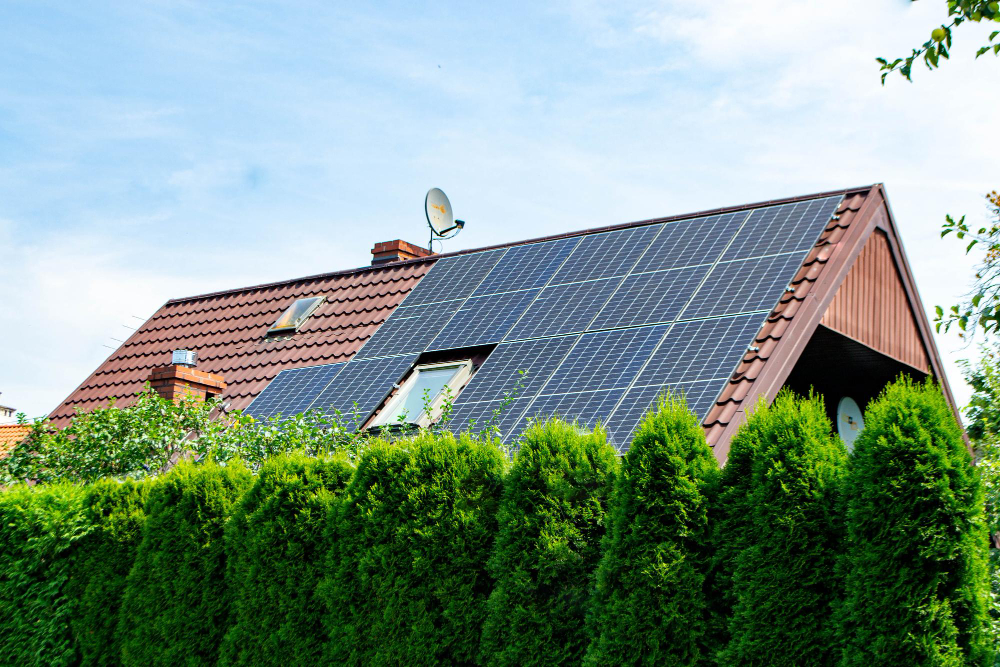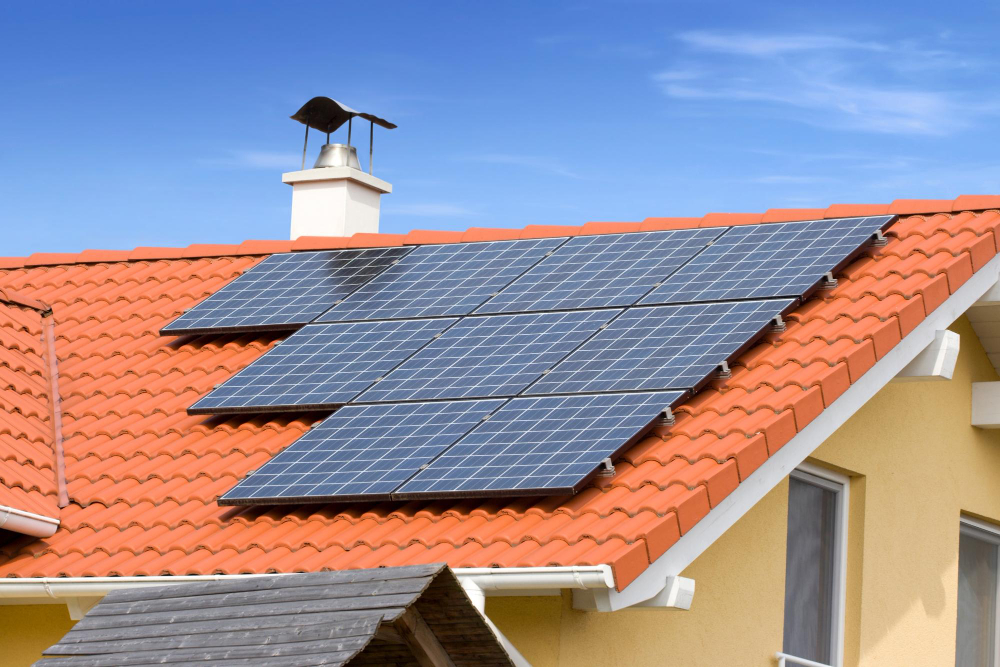Solar shingles are transforming the way homeowners approach clean energy and roofing design. Instead of mounting bulky solar panels on top of your existing roof, these advanced products form the roof itself, offering both weather protection and energy generation in a single, elegant package.
In this guide, you’ll learn:
- What solar shingles are and how they work
- Their benefits and drawbacks
- Installation process and requirements
- Costs and long-term savings potential
- Maintenance needs and lifespan
- How to decide if they’re right for your home
What Are Solar Shingles?
Solar shingles sometimes called photovoltaic (PV) shingles or solar roof tiles, are a type of building-integrated photovoltaic (BIPV) product. They resemble traditional roofing materials like asphalt shingles, slate, or tile but contain embedded solar cells that capture sunlight and convert it into electricity.
They’re designed to replace conventional roof materials while providing the added benefit of renewable power generation.
How Do Solar Shingles Work?
The process is simple but efficient:
- Sunlight Absorption: Photovoltaic cells in each shingle capture solar energy during daylight hours.
- Electricity Generation: The absorbed sunlight is converted into direct current (DC) electricity.
- Power Conversion: An inverter transforms DC into alternating current (AC) for use in your home.
- Energy Flow: The electricity is used immediately, stored in batteries for later use, or fed back into the grid for credit through net metering.
Types of Solar Shingles
- Crystalline Silicon Shingles: Similar to traditional solar panels, these offer higher efficiency and durability.
- Thin-Film Solar Shingles: Lightweight and easier to install, though slightly less efficient than crystalline silicon options.
Advantages of Solar Shingles
- Seamless Aesthetics: These shingles integrate directly into your roof, creating a streamlined look without the bulky appearance of traditional panels perfect for neighborhoods with strict HOA guidelines.
- Dual Purpose Functionality: They serve as both a protective roof covering and a renewable energy source, giving you two upgrades in one investment.
- Energy Cost Reduction: Solar shingles can drastically reduce or even eliminate monthly electric bills, delivering thousands of dollars in potential savings over their lifetime.
- Weather Resistance: Designed to withstand high winds, heavy rain, hail, and snow, with many models meeting strict storm-resistance building codes.
- Increased Property Value: Homes equipped with solar often sell faster and at higher prices, attracting buyers interested in sustainability and lower utility costs.
- Environmental Benefits: They reduce reliance on fossil fuels, helping to cut your household’s carbon footprint.
- Low-Profile Technology: Eliminates the need for large rack-mounted panels, preserving the visual appeal of your home.

Potential Drawbacks of Solar Shingles
- Higher Upfront Cost: Generally more expensive than both traditional roofing and standalone solar panel systems, especially without incentives.
- Lower Efficiency: Because shingles lie flat on the roof, they may not capture as much sunlight as optimally angled panels.
- Limited Installer Availability: Installation requires expertise in both roofing and solar systems, and not all contractors have this dual skill set.
- Best for Full Roof Replacements: They’re ideal when replacing your roof but less practical for retrofits.
- Long Payback Period: Depending on location, energy usage, and available incentives, it can take years sometimes over a decade to recover the investment.
- Product Availability: Fewer manufacturers and style options compared to traditional solar panels.
Installation Process of Solar Shingles
- Roof Assessment: Evaluate roof structure, angle, and sunlight exposure.
- Design & Planning: Determine system size, layout, and electrical connections.
- Old Roof Removal (if needed): Prepare the deck for installation.
- Shingle Installation: Place solar shingles alongside non-solar ones where appropriate.
- Electrical Integration: Connect to the inverter and your home’s electrical system.
- Inspection & Activation: Pass local code inspections and activate the system.
Costs & Return on Investment
- Price Range: Installation costs generally fall between $20,000 and $40,000 or more, depending on roof size, product brand, and energy capacity.
- Cost Comparison: Higher than traditional panels, but they replace your roofing material, offsetting some of the expense.
- Incentives & Tax Credits: Federal tax credits can reduce costs by up to 30%, and many states or utilities offer additional rebates.
- Energy Bill Savings: Annual savings can range from hundreds to thousands of dollars, depending on system size and location.
- Home Value Boost: Solar-equipped homes often fetch higher prices in the real estate market.
- Payback Timeline: Varies widely typically between 7 and 15 years depending on energy costs and available incentives.
Lifespan & Maintenance
- Expected Lifespan: Most last between 20–30 years, similar to high-quality asphalt shingles.
- Durability: Built to handle harsh climates, including strong UV rays, hail, and heavy storms.
- Cleaning Needs: Occasional rinsing or professional cleaning to remove dust, pollen, and debris for optimal performance.
- Inspection Frequency: Annual inspections help catch and correct issues early.
- Repairs & Replacements: Individual shingles can often be replaced without disturbing the rest of the system, but work should be done by qualified installers.
- Monitoring Systems: Many systems come with apps or online platforms for tracking energy output and system health.

Solar Shingles vs. Traditional Solar Panels vs. Standard Roofing
| Feature | Solar Shingles | Traditional Solar Panels | Standard Roofing |
| Primary Function | Roof covering + electricity generation | Electricity generation only | Roof covering only |
| Appearance | Sleek, integrated with roofline | Mounted on top of existing roof | Standard roofing look |
| Energy Efficiency | Moderate to high, depends on sunlight exposure | High, can be angled for optimal performance | None |
| Installation | Replaces roofing material; best for new roofs or full replacements | Installed on top of existing roof | Installed during roof build or replacement |
| Durability | 20–30 years, weather-resistant | 25–30 years | Varies (15–50 years depending on material) |
| Cost Range | $20,000–$40,000+ | $15,000–$25,000+ | $5,000–$20,000 depending on material |
| Incentives Available | Yes (solar incentives and tax credits) | Yes (solar incentives and tax credits) | No |
| Maintenance Needs | Low; occasional cleaning and inspections | Low; occasional cleaning and inspections | Varies; periodic inspections and repairs |
| Best For | Homeowners wanting an integrated, modern look and dual-purpose system | Homeowners maximizing energy production without replacing roof | Homeowners seeking roof protection without solar power |
| Payback Period | 7–15 years | 5–12 years | No direct energy savings |
When Are Solar Shingles the Right Choice?
- You’re building a new home or planning a full roof replacement.
- Your roof has excellent sunlight exposure for most of the day.
- You want a modern, integrated roof design rather than traditional solar panels.
- You have access to incentives or rebates to offset costs.
- You plan to stay in your home long enough to see long-term savings.
Conclusion
Solar shingles offer a cutting-edge, visually appealing way to power your home sustainably while doubling as a durable roofing solution. While they come with a higher price tag than other options, their sleek design, dual-purpose functionality, and potential long-term savings make them an attractive choice for homeowners in sunny climates. By considering your roof’s condition, energy needs, and available incentives, you can determine if solar shingles are the right investment for your home.


